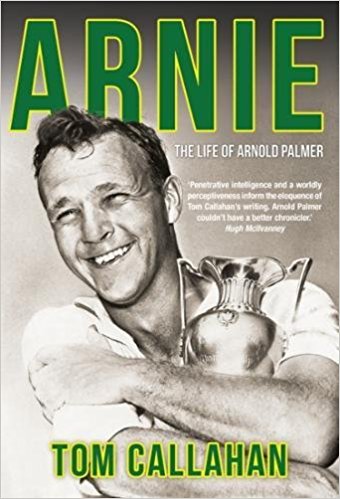Arnie: The Life of Arnold Palmer
- By Tom Callahan
- Harper
- 352 pp.
- Reviewed by Fred Bowen
- May 8, 2017
Remembering the “nice guy” who put golf on America’s map.

Arnold Palmer was arguably the most important professional golfer of all time, but that’s not to say he was the best. Jack Nicklaus and Tiger Woods, for instance, have won more tournaments and major championships. Even Gary Player and Tom Watson have more career majors than Palmer.
But Palmer put professional golf on the map in the late 1950s and early 1960s. Or, more specifically, he put it on television. Hitching his pants, taking chances, and sinking putts from everywhere, Palmer breathed life into a slow, staid game. He made golf dramatic, compelling, and with his bronzed face and big forearms…sexy.
Think for a moment if a skilled but faceless practitioner, such as Billy Casper or Julius Boros, had won Palmer’s 62 PGA titles and seven majors. Would today’s pros be playing for the millions as they do every weekend? I doubt it. The camera loved Palmer, so people, in turn, loved Arnie, and learned to love golf.
Palmer put money in the pocket of every pro who followed him. He also made plenty of his own over the years as an endorser extraordinaire. As Tom Callahan points out in Arnie: The Life of Arnold Palmer, “In his mid-80s, without hitting a single shot that counted, Arnold was still earning $40 million a year under his perfect logo, an umbrella.”
Callahan, a veteran golf and sports writer for Time Magazine and the Washington Post, has clearly talked to everyone, including Palmer, over his many years of covering the professional tour. His book is not as much a serious biography as a grab-bag of stories about the legendary golfer and his impact upon the game.
For example, early in the book, when he is describing Palmer’s time in the Coast Guard and his efforts to get his golf career started, Callahan mentions Palmer served as part of the honor guard at the Washington premiere of the movie “Fighting Coast Guard.” In the next two (!) pages, Callahan somehow fits in stories of:
- Movie star Esther Williams.
- Palmer’s transfer to Cleveland after he broke another seaman’s arm in a jujitsu class.
- Palmer getting propositioned by a man while hitchhiking to Pennsylvania.
- Palmer’s job selling paint and playing “salesman’s golf.”
- His return to Wake Forest and his victory in the ACC individual championship.
- His speech to the graduates at Wake Forest many years later (Palmer never graduated).
- Bobby Jones’ efforts to convince Jack Nicklaus to remain an amateur.
- Quotes from golfer Dow Finsterwald about Arnie’s love of cowboy movies.
- Observations by Lee Trevino that he and Palmer were alike in the need to “slap rubber” (practice every day).
This bewildering piling on reminds me of being in the company of a genial raconteur who is constantly saying, “And that reminds me of another story…”
Some of the stories in Arnie are expected. Callahan describes Palmer’s relationship with his father. Milfred “Deacon” Palmer was a demanding dad who never seemed to give his son the approval he craved.
There are also stories of Palmer’s evolving relationship with rival Nicklaus. At first, Palmer was jealous of Nicklaus’ enormous talent, while Nicklaus was jealous of Palmer’s popularity. They grew closer over the years because of many rounds of golf, including numerous worldwide exhibitions together.
Finally, there are countless testimonials of Palmer’s friendly personality and unique connection with golf galleries. As Palmer’s agent and business partner, Mark McCormack, observed, “The greatest thing about Palmer is that his instinct for kindness, even at the most critical moments, overtakes his tremendous desire to win.”
McCormack added, “I’ve been around a lot of great athletes, and I believe he’s the only great athlete…whom you can say that about.” Or, as Nicklaus said at the ceremony in 2012 where Palmer received the Congressional Gold Medal, “He won four green jackets, but he never lost his blue collar.”
Other stories are less expected. Who knew that Palmer grew up with Mr. Rogers? Or that he flew a plane around the world in 1976? Or that Palmer’s wife, Winnie, had to put up with what Callahan describes as Palmer’s “well-known womanizing”?
Palmer’s fans and golf enthusiasts alike will enjoy many of the stories. But I doubt the book will reach much beyond the golf crowd. The best sports books (I am thinking of The Match: The Day the Game of Golf Changed Forever by Mark Frost) are deep dives into the game, examinations of the times and how the sport fit into the historical era.
Callahan’s workmanlike effort in Arnie reminds me of what my brother and longtime golfing partner, Rich, would call “a son-in-law shot.” Adequate, but not what I was hoping for.
Fred Bowen is the author of 22 sports books for kids ages 7 to 12. The latest is a basketball book, Outside Shot. He has also written a weekly sports column for the KidsPost page of the Washington Post since April 2000.

